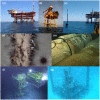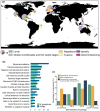Influence of offshore oil and gas structures on seascape ecological connectivity
- PMID: 35293658
- PMCID: PMC9311298
- DOI: 10.1111/gcb.16134
Influence of offshore oil and gas structures on seascape ecological connectivity
Abstract
Offshore platforms, subsea pipelines, wells and related fixed structures supporting the oil and gas (O&G) industry are prevalent in oceans across the globe, with many approaching the end of their operational life and requiring decommissioning. Although structures can possess high ecological diversity and productivity, information on how they interact with broader ecological processes remains unclear. Here, we review the current state of knowledge on the role of O&G infrastructure in maintaining, altering or enhancing ecological connectivity with natural marine habitats. There is a paucity of studies on the subject with only 33 papers specifically targeting connectivity and O&G structures, although other studies provide important related information. Evidence for O&G structures facilitating vertical and horizontal seascape connectivity exists for larvae and mobile adult invertebrates, fish and megafauna; including threatened and commercially important species. The degree to which these structures represent a beneficial or detrimental net impact remains unclear, is complex and ultimately needs more research to determine the extent to which natural connectivity networks are conserved, enhanced or disrupted. We discuss the potential impacts of different decommissioning approaches on seascape connectivity and identify, through expert elicitation, critical knowledge gaps that, if addressed, may further inform decision making for the life cycle of O&G infrastructure, with relevance for other industries (e.g. renewables). The most highly ranked critical knowledge gap was a need to understand how O&G structures modify and influence the movement patterns of mobile species and dispersal stages of sessile marine species. Understanding how different decommissioning options affect species survival and movement was also highly ranked, as was understanding the extent to which O&G structures contribute to extending species distributions by providing rest stops, foraging habitat, and stepping stones. These questions could be addressed with further dedicated studies of animal movement in relation to structures using telemetry, molecular techniques and movement models. Our review and these priority questions provide a roadmap for advancing research needed to support evidence-based decision making for decommissioning O&G infrastructure.
Keywords: birds; ecosystem function; fish; hydrodynamics; invasive species; larval dispersal; marine megafauna; particle tracking; subsea infrastructure.
© 2022 Crown copyright and Commonwealth of Australia. Global Change Biology published by John Wiley & Sons Ltd. This article is published with the permission of the Controller of HMSO and the Queen's Printer for Scotland. This article has been contributed to by U.S. Government employees and their work is in the public domain in the USA.
Conflict of interest statement
This paper is the result of a study funded by National Decommissioning Research Initiative (NDRI) with the NDRI having received funding from the Oil and Gas industry sector and Australian Government. Funding from the NDRI supported the core project team (authors DM, LC, MT, JB, KM, M‐LS). This funding source has not influenced any of the authors objectivity. We have no further potential conflicts of interest to disclose.
Figures





References
-
- Adams, T. P. , Miller, R. G. , Aleynik, D. , & Burrows, M. T. (2014). Offshore marine renewable energy devices as stepping stones across biogeographical boundaries. Journal of Applied Ecology, 51, 330–338. 10.1111/1365-2664.12207 - DOI
-
- Adelir‐Alves, J. , Soeth, M. , Braga, R. R. , & Spach, H. L. (2018). Non‐native reef fishes in the Southwest Atlantic Ocean: A recent record of Heniochus acuminatus (Linnaeus, 1758) (Perciformes, Chaetodontidae) and biological aspects of Chromis limbata (Valenciennes, 1833) (Perciformes, Pomacentridae). Check List, 14, 379–385. 10.15560/14.2.379 - DOI
-
- Adewole, G. M. , Adewale, T. M. , & Ufuoma, E. (2010). Environmental aspect of oil and water‐based drilling muds and cuttings from Dibi and Ewan off‐shore wells in the Niger Delta, Nigeria. African Journal of Environmental Science and Technology, 4, 284–292.
-
- Ajemian, M. J. , Wetz, J. J. , Shipley‐Lozano, B. , Shively, J. D. , & Stunz, G. W. (2015). An analysis of artificial reef fish community structure along the northwestern Gulf of Mexico shelf: Potential impacts of “Rigs‐to‐Reefs” programs. PLoS One, 10, e0126354. 10.1371/journal.pone.0126354 - DOI - PMC - PubMed
-
- Almeida, L. P. , & Coolen, J. W. P. (2020). Modelling thickness variations of macrofouling communities on offshore platforms in the Dutch North Sea. Journal of Sea Research, 156, 101836. 10.1016/j.seares.2019.101836 - DOI
Publication types
MeSH terms
LinkOut - more resources
Full Text Sources
Miscellaneous

